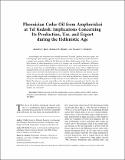Phoenician Cedar Oil from Amphoriskoi at Tel Kedesh: Implications Concerning Its Production, Use, and Export during the Hellenistic Age
Author(s)
Koh, Andrew J.; Berlin, Andrea M.; Herbert, Sharon C.
DownloadKoh 2021.pdf (1.996Mb)
Publisher Policy
Publisher Policy
Article is made available in accordance with the publisher's policy and may be subject to US copyright law. Please refer to the publisher's site for terms of use.
Terms of use
Metadata
Show full item recordAbstract
Archaeologists and historians have routinely attributed “branded” goods to particular regions and cultural groups, often without rigorous analysis. Phoenician cedar oil is perhaps one of the best-known examples from antiquity. Hellenistic Tel Kedesh in the Upper Galilee region of the Levant is particularly relevant for these discussions by virtue of its strategic role as a border settlement in Phoenicia during one of the most dynamic periods in ancient history. As a concise contribution to these discussions, we present here an interdisciplinary analysis of amphoriskoi found with ca. 2,000 impressed sealings from the archive complex of the Persian-Hellenistic Administrative Building. While the building was constructed under the Achaemenids and occupied in both the Ptolemaic and Seleucid eras, the archive was in use only under the Seleucids in the first half of the of the 2nd century b.c.e. Blending organic residue analysis with archaeological and textual data has allowed us to identify with certainty one of the value-added goods most closely attached to ancient Phoenicia, true cedar oil from Cedrus libani. This discovery not only empirically verifies this well-known association for the first time, but also provides a rich context in which to test our assumptions about culturally-branded goods, the role they played in participant societies, and the mechanisms and systems in place that facilitated their production, use, and export.
Date issued
2021-05-01Journal
Bulletin of the American School of Oriental Research
Publisher
University of Chicago Press
Citation
Koh, Andrew J., Berlin, Andrea M. and Herbert, Sharon C. 2021. "Phoenician Cedar Oil from Amphoriskoi at Tel Kedesh: Implications Concerning Its Production, Use, and Export during the Hellenistic Age." Bulletin of the American School of Oriental Research, 385.
Version: Final published version
ISSN
0003-097X
2161-8062
Keywords
Archeology, History, Cultural Studies, Archeology